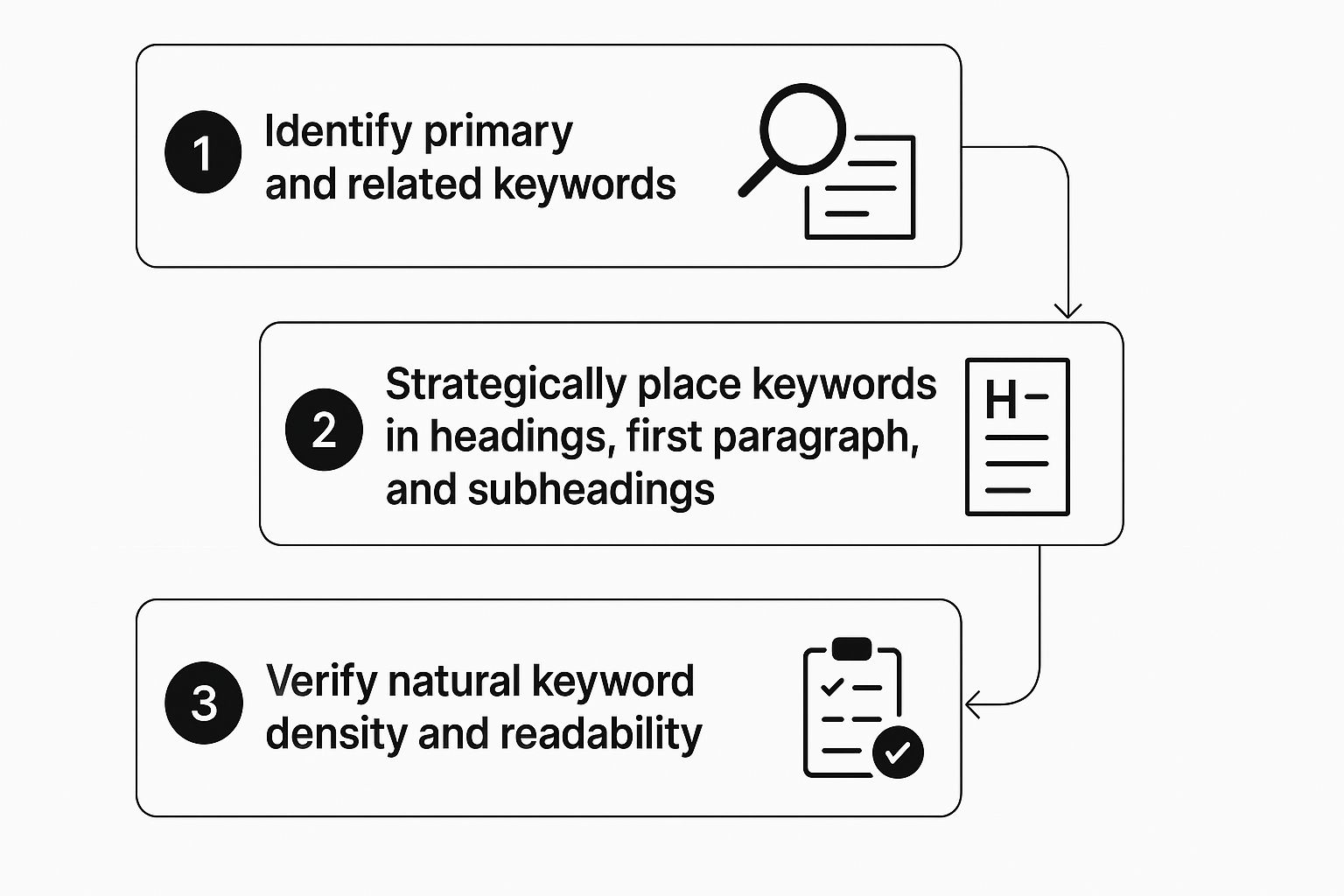
How to Write SEO Friendly Blog Posts That Rank
Share
Writing a blog post that truly performs in search engines is about more than just good writing. It's about creating a piece of content that both answers your audience's real questions and is perfectly structured for search engines like Google to crawl and understand. It's that sweet spot where human-centric content meets smart technical optimization.
Why SEO-Friendly Blog Posts Are a Long-Term Asset

It's easy to fall into the trap of treating blog posts as one-and-done marketing tasks. You write it, hit publish, and immediately start worrying about the next one. But that perspective completely misses the point.
A truly SEO-friendly blog post isn't a temporary campaign—it's a permanent digital asset. It’s your best employee, working around the clock to generate leads, build your brand's authority, and drive traffic 24/7, long after the initial publication date.
Think of it this way: a social media post might grab attention for a few hours, maybe a day if you're lucky. A well-optimized blog post, on the other hand, is like owning a piece of prime digital real estate. It can attract a steady stream of visitors for years, becoming a cornerstone of your online presence and continuously growing in value.
The Compounding Value of Optimized Content
Every single optimized article you publish creates a brand-new doorway to your website. When you write a blog post that ranks for valuable keywords in your niche, you're not just getting a temporary spike in traffic. You're building a sustainable pipeline of potential customers.
And this isn't just random traffic. It's highly qualified because these are people actively searching for the information and solutions you provide. This consistent flow of engaged visitors creates a powerful ripple effect across your entire business.
- Builds Topical Authority: Publishing high-quality content on a specific subject time and time again signals to Google that you're an expert. This helps your entire site rank better for related terms.
- Generates Evergreen Leads: A single post that solves a timeless customer problem can continue to capture leads and drive sales for months, or even years, with little to no extra effort.
- Reduces Ad Spend: As your organic visibility grows, you become less reliant on paid ads to get in front of customers, which can significantly lower your acquisition costs over time.
Setting a Strong Foundation
Before we get into the nitty-gritty of writing, it's critical to have a solid grasp of what Search Engine Optimization (SEO) is at its core. You can learn more about where this traffic comes from by exploring our guide on https://restaurantequipmentseo.com/blogs/restaurant-equipment-seo-blog/what-is-organic-traffic.
Understanding these fundamentals is the absolute first step toward creating content that actually gets results. The truth is, blogging isn't just a side project anymore. Projections show that by 2025, a staggering 80% of businesses will be using blogs as a core part of their marketing strategy.
Even more telling? Companies that blog are 13 times more likely to see a positive ROI from their efforts. This shift makes it crystal clear: mastering SEO-friendly content is no longer optional—it's essential for long-term growth.
To bring it all together, here’s a quick breakdown of the core pillars that make a blog post truly "SEO-friendly." Think of these as the essential ingredients you can't skip if you want your content to rank and resonate.
Core Pillars of an SEO Friendly Blog Post
| Pillar | What It Is | Why It Matters for SEO |
|---|---|---|
| Keyword Research | The process of finding the exact words and phrases your target audience uses to search for information. | Aligns your content with user intent, ensuring you show up for relevant searches and drive qualified traffic. |
| High-Quality Content | Well-written, comprehensive, and genuinely helpful information that fully answers the user's query. | Google prioritizes content that satisfies users. High-quality posts earn longer dwell times and lower bounce rates, which are positive ranking signals. |
| On-Page Optimization | The practice of optimizing individual web page elements like titles, headings, and images for your target keyword. | Helps search engines understand the page's topic and relevance, making it easier for them to rank it correctly. |
| User Experience (UX) | Ensuring your content is easy to read, navigate, and visually appealing on all devices. | A positive UX keeps visitors on your page longer. Factors like mobile-friendliness and page speed are direct ranking factors. |
Mastering these four pillars is the foundation for creating content that doesn't just get published, but actually performs for your business month after month.
Decoding Search Intent and Finding Your Keywords
Great SEO doesn't start with writing. It starts with listening. Before you type a single word, you have to get inside your customer's head and understand the "why" behind their search. This is what we call search intent—the real goal a person has when they turn to Google.
Skipping this step is like a chef trying to cook a meal without knowing what the customer ordered. You can create something, but it won't be what they wanted. Content that misses the mark on search intent will never connect with its audience, and Google knows it. A huge part of this is choosing the best keywords for SEO that line up perfectly with what your audience is actually thinking.
The Four Flavors of Search Intent
Every single search query can be boiled down to one of four main categories. Once you get these, you can craft content that feels like it’s reading the user's mind.
- Informational: The user needs an answer. They're looking for knowledge. Think "how to clean a commercial deep fryer" or "what temperature should a walk-in cooler be."
- Commercial: The user is kicking the tires before a purchase. They're weighing their options with searches like "Hoshizaki vs Manitowoc ice machines" or "best commercial convection ovens."
- Transactional: The user has their wallet out and is ready to buy. These searches are direct and to the point: "buy True T-49 refrigerator" or "commercial kitchen design services near me."
- Navigational: The user already knows where they want to go. For instance, they might just type "Restaurant Equipment SEO blog" to find our site directly.
The real secret is matching your content to the user's intent. If someone searches for "best commercial ovens," they want a detailed comparison guide, not your homepage. A mismatch here is the fastest way to have them hit the back button.
Uncovering What Your Audience Really Wants
So, where do you find these golden keywords and questions? Forget the expensive, complicated tools for a minute. Let's start with what’s right in front of you.
Your best friend is Google itself. Seriously. Start typing a broad term like "commercial refrigeration" into the search bar and look at what it suggests. Then, scroll down to the "People Also Ask" box on the results page. This is a goldmine, showing you the exact questions real restaurant owners are asking.
Next, go where the real conversations are happening. Check out forums like Reddit—subreddits like r/restaurantowners or r/chefit are fantastic—and other industry communities. The language here is raw and unfiltered. It gives you a direct line into the biggest headaches, urgent questions, and specific needs of your ideal customers. This is where you'll discover those valuable long-tail keywords—the longer, more specific phrases that tell you someone is much closer to making a purchase.
While you can—and should—go after more than one keyword in a post, you need a smart strategy. To get the full picture, check out our guide on how many keywords to target per page in our detailed guide. This will help you keep your article focused without leaving valuable traffic on the table.
Structuring Your Post for Readers and Search Engines

Alright, you've done the keyword research and you know what your audience is looking for. Now comes the fun part: actually building the article. A solid structure is everything. Without it, even the best research is wasted. Think of your post's structure as the blueprint that guides both your readers and the search engine crawlers right where you want them to go.
It all starts with your main title—your H1 tag. It needs to be catchy and include your primary keyword. I’ve found that headlines between 6 and 13 words tend to pull in the most traffic. From there, you'll use H2 and H3 subheadings to break the content down into smaller, logical chunks.
This isn’t just about making things look pretty. It's about how people actually read online. Let’s be real: most people don't read every single word. Data shows that a staggering 73% of readers skim blog posts. They might spend seven minutes on the page, but they're scanning for the good stuff. If your article is a giant wall of text, they're gone. You can dive deeper into these blogging statistics from Databox if you're curious.
Building a Scannable Hierarchy
The core principle here is simple: make it ridiculously easy for someone to find what they're looking for. A busy restaurant owner should be able to glance at your subheadings and know exactly what each part of your article is about.
First, lock in that powerful H1 title. This is your article's one and only main headline, so make it count.
Next, you'll use H2 subheadings to map out the major sections. If you're writing about "commercial convection ovens," your H2s could be things like "How Convection Ovens Work," "Key Features to Look For," and "Top Brands Compared." See how that creates a clear path?
Then, you can drill down even further with H3 subheadings. Under that "Key Features to Look For" H2, you could add H3s for "Fan Speed Controls" and "Energy Efficiency Ratings." This nested structure creates a logical flow that both people and search engines love.
Using Formatting for Maximum Impact
Beyond your headings, the way you format the text itself is your secret weapon. Nothing scares a reader away faster than a dense, intimidating block of text. Your goal is to create visual breaks that make skimming easy and pull the reader's eye to the most important bits of information.
Keep your paragraphs short. I mean really short—one to three sentences, max. This injects much-needed white space and makes the content feel approachable.
You should also lean on other formatting tools to make key takeaways pop:
- Bullet points are your best friend for listing features, benefits, or quick tips. They break up the monotony of paragraphs.
- Numbered lists are perfect when you're outlining a step-by-step process or ranking items. They provide a clear sequence for the reader to follow.
- Use bold text, but don't overdo it. It's great for highlighting critical terms, stats, or a final thought you absolutely want them to see.
Pro Tip: I like to think of formatting as creating visual signposts. Every bolded phrase, bullet point, or short paragraph is another signal helping a skimming reader quickly pull out the most valuable information from your article.
Mastering On-Page SEO Without Sounding Like a Robot
Okay, you've got a solid structure for your article. Now comes the part where we dial in the on-page elements. This isn't about stuffing keywords everywhere; it's about strategically placing them to send clear signals to search engines about what your content is about. The goal is to do this while keeping the writing completely natural and helpful for a human reader.
Think of it like organizing a massive library. On-page SEO is how you label the spines of your books and categorize them correctly. You're making it incredibly easy for Google to find your content and serve it up to the right person.
Weaving Keywords into Your Content
The real art of on-page optimization is subtlety. You don't want your keywords to stick out like a sore thumb. Forcing them into sentences where they don't belong is a surefire way to turn readers off and can even hurt your rankings. It's an old-school tactic that just doesn't work anymore.
Instead, focus on placing your main keyword in a few high-impact spots:
- Title Tag: This is the big one. It's the headline people see in the search results. Your main keyword absolutely needs to be here, and the closer to the beginning, the better.
- Meta Description: While Google says this isn't a direct ranking factor, a well-written meta description with your keyword can be the difference-maker. It convinces people to click on your link instead of the competition's. A higher click-through rate (CTR) is a huge positive signal to Google.
- The First 100 Words: Drop your primary keyword somewhere in the opening paragraph. This immediately confirms the topic for both your readers and search engine crawlers.
- H1 and H2 Headings: Your article's main title (the H1) and at least one of your main subheadings (an H2) should naturally include your primary keyword or a very close variation.
Getting this flow right is crucial. It's about placing keywords thoughtfully and then stepping back to make sure it all reads smoothly.

As you can see, the process doesn't end with just placing keywords. You have to verify that the content still flows naturally for the end user.
Optimizing Your URL and Images
Don't sleep on these two elements. Your page's URL and image alt text are often-overlooked but provide powerful context that helps search engines fully understand your content.
A clean, short URL (the "slug") is far more effective than a long, jumbled one generated by your content management system. For instance, a URL like .../blog/best-commercial-ovens tells you exactly what the page is about. A messy one like .../blog/post-id-7892-top-choices-for-ovens-in-your-restaurant-kitchen-2024 is just noise.
Image alt text is just as critical. This is the text that describes an image for visually impaired users using screen readers, and it also tells search engines what the image depicts. Instead of a generic filename, write a simple, descriptive phrase that includes a relevant keyword.
A well-optimized image with descriptive alt text isn't just an accessibility feature; it's another opportunity for your content to appear in Google Image Search, creating an additional traffic stream.
If you want to go even deeper on these tactics, our comprehensive guide breaks down exactly what on-page optimization is and why it matters.
Building a Smart Internal Linking Strategy
Finally, let's talk about internal links. These are the threads that weave your content together, building a strong web of topical authority across your site. When you link from one blog post to another relevant post, you're doing two very important things.
First, you're giving your readers a path to more of your great content, which keeps them on your site longer. Second, you're helping search engines discover your other pages and, more importantly, understand how they all relate to each other. For example, linking from a new post about "commercial ovens" to an older one on "oven maintenance tips" reinforces your expertise in that entire category.
On-Page SEO Before and After Optimization
Seeing the difference can make it all click. This table shows some common mistakes and how simple fixes can dramatically improve your on-page SEO.
| On-Page Element | Poorly Optimized Example | Well-Optimized Example |
|---|---|---|
| URL Slug | /p?123-final-draft |
/how-to-clean-commercial-griddle |
| Image Alt Text | image123.jpg |
A stainless steel commercial griddle being cleaned |
| Internal Link | Click here to read more. |
Learn more in our guide to commercial griddle maintenance. |
As you can see, the optimized examples are clear, descriptive, and provide value to both users and search engines. It's these small, intentional details that separate content that just exists from content that actually ranks.
Writing Content That People Actually Want to Link To

Getting your content to rank on Google is a huge win, but the real goal is to become the go-to authority in the restaurant equipment space. The clearest sign you’ve made it? When other credible websites start linking to your content without you even having to ask. These natural backlinks are pure gold—one of the strongest signals you can send to search engines.
To get them, your content has to be more than just good. It needs to be an indispensable resource, something we in the SEO world call a “linkable asset.” This is the kind of content that’s so genuinely useful and insightful that other industry writers and experts feel they have to reference it in their own work.
Put yourself in their shoes for a moment. When a journalist or blogger is writing an article, they need credible sources to back up their points. Your job is to create the best possible source for them to find and link to.
Add Something New to the Conversation
The secret to creating a linkable asset is originality. You can’t just rehash what’s already on page one of Google. You need to bring something fresh to the table that makes your content uniquely valuable.
Don't worry, this doesn't mean you need a massive research budget. Originality can take many forms:
- Your Own Data: Have you noticed an interesting trend in your sales data? Can you run a quick survey of your customers? Even a simple poll can produce a unique statistic that other writers will be eager to cite.
- Expert Commentary: Go interview a well-known chef or a veteran restaurant consultant about a specific piece of equipment. Including their direct quotes adds immediate authority and a perspective that can't be found anywhere else.
- Unique Visuals: A custom infographic, a detailed comparison chart, or even a well-produced video can make a complex topic easy to understand. Visuals are prime link bait because they’re so easy for others to embed in their own articles (with a credit link back to you, of course).
I've found the most powerful approach is to mix and match these tactics. Imagine creating a "State of the Commercial Kitchen" report. You could combine proprietary survey data, quotes from several industry pros, and a sharp infographic summarizing the key findings. An asset like that becomes the definitive resource on the topic.
Go Deep, Be Comprehensive
While it's not just a numbers game, comprehensive content almost always attracts more links. It’s pretty simple: a detailed guide that explores a topic from all angles is just more useful—and therefore more linkable—than a quick, surface-level post.
Going deep on a subject demonstrates your expertise and leaves the reader with no unanswered questions. It becomes their one-stop-shop. The data backs this up, too. One study analyzing 11.8 million Google search results found a direct link between content length and backlinks. Articles between 3,000 and 10,000 words earned links from over four different websites on average, while pieces under 1,000 words barely got two.
Even though the average first-page result is about 1,447 words, the takeaway is clear: in-depth content becomes a natural magnet for links. You can dig into more of these blogging statistics and their impact on SEO to see the trends.
This entire philosophy—creating genuinely indispensable content—is the foundation of writing blog posts that truly perform in search. When you focus on creating value that other people want to share, you naturally build a powerful backlink profile that will cement your rankings for years to come.
Common Questions About SEO Blog Writing
https://www.youtube.com/embed/uNKcis-wnro
Even with a solid game plan, you're bound to run into some specific questions when you're getting the hang of writing SEO-friendly blog posts. Let's dig into some of the most common ones I hear all the time.
How Important Is Keyword Density?
This is a classic, but the answer has evolved quite a bit. My advice? Forget about hitting some magic number like a 1-2% keyword density. That’s old-school thinking, and it's a surefire way to make your content sound clunky and unnatural.
These days, it’s all about topical relevance. Google’s gotten much smarter. Instead of seeing the same exact phrase repeated over and over, it wants to understand if you’ve covered a topic from all angles. This means using your main keyword, of course, but also weaving in synonyms, related concepts, and different long-tail variations. Just focus on writing a genuinely helpful, thorough answer for a real person, and you'll find the right keywords just naturally become part of the conversation.
Does Blog Post Length Really Matter for SEO?
It does, but not in the way most people think. You’ll see a lot of data showing a strong link between longer content and better rankings, but simply padding your word count is a waste of time. A rambling 3,000-word article full of fluff will never beat a sharp, focused 1,500-word post that gets straight to the point and solves the reader's problem.
So, how long should it be? Long enough to be the single best, most complete resource on the internet for that topic. No more, no less. For highly competitive topics, that usually means you'll need to write something more substantial. When a 2024 study shows the #1 spot on Google pulls in a staggering 39.8% of all clicks, being the most thorough answer isn't just a suggestion—it's a necessity.
Should I Update Old Blog Posts?
Yes! A thousand times, yes. This is called historical optimization, and honestly, it’s one of the most powerful and overlooked SEO tactics out there. What worked two years ago might not work today because search algorithms, competitor content, and what users expect are constantly changing.
Make it a habit to go back and look at your older content. Find the posts that have flatlined or started to slip in the rankings. You can get some serious traction by:
- Refreshing stale information and updating old statistics.
- Improving the formatting to make it easier to read and scan.
- Adding new sections to cover the topic more comprehensively.
- Optimizing for new keywords you might have missed the first time around.
Don't let your old content just sit there gathering digital dust. A strategic update can breathe new life into an existing asset, often delivering results much faster than creating a brand-new post from scratch.
How Do I Measure the Success of My Post?
Success is way more than just a traffic spike. To get the real story, you need to look at a combination of metrics, primarily from tools like Google Search Console and Google Analytics.
Keep an eye on the post's organic traffic over time, track where it's ranking for your target keywords, and watch how many new backlinks it earns. But the real proof is in the pudding: Is it actually driving business? Track things like leads generated or contact form submissions. That’s how you know your content isn't just ranking—it's actually making you money.
At Restaurant Equipment SEO, we specialize in turning your blog into an asset that fuels real business growth. Our team lives and breathes this stuff, handling everything from the initial keyword strategy to writing content that ranks and converts.
Ready to see what a professional SEO content strategy can do for your business? Learn more about our services.